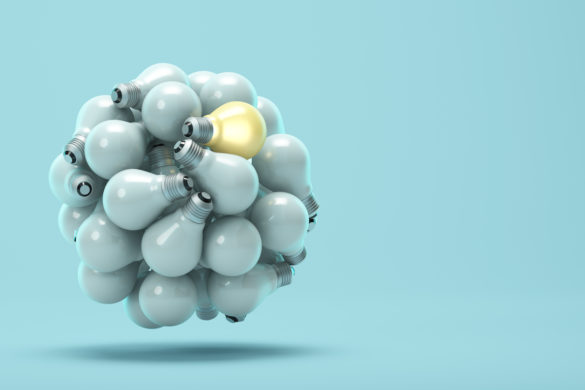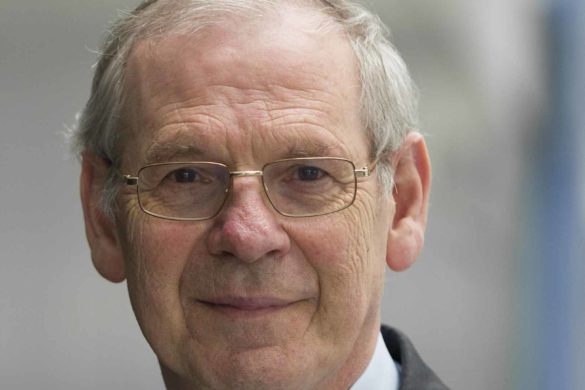Romania geographically belongs to Eastern Europe, but by history, tradition and culture it is perfectly expressing the values of an United Europe. With the Danube River as a large part of our Southern border (with Serbia and Bulgaria), the Danube Delta and the Black Sea Coast in the south –eastern part, the arch of the Carpathian Monuntains in the center of the country, plenty of rivers and lakes, Romania has beautiful landscapes, ready to charm any guest.
We have a four season climate, winters still bring snow on the mountains, and we enjoy skiing in several ski resorts, one of the best being Poiana Brasov, near Brasov, with a wonderful medieval architecture in the historic center.
With 14 peaks above 2500 m height (three of them being in the Fagaras Mountains) and 255 above 2000 m, hiking lovers have a lot of opportunities to challenge themselves by climbing narrow pathways to the top, watched by marmosets or chamois.
Beside the natural scenery, our history is whispering from every corner. Ancient dacian or roman ruins, medieval churches and castles, or architectural monuments closely related to our modern history, each one tells a story which is worth to hear. The Bran Castle (left panel) tells the story of Vlad Tepes (a prince from the XVth century), whereas the Peles Castle (right panel) the story of Carol I of Romania, a prince from the Hohenzollern- Sigmaringen family who was our king between 1866- 1914. Both kings, although in a completely different manner determined by the hystorical period, fought for the political and cultural independence of the romanian people.
Although the rhythm of life is constantly increasing its pace, and people in urban areas are rapidly adapting to technological progress (we have one of the fastest internet networks in world), the countryside is still fond of tradition, with people taking up small or large scale agriculture, from raising cattle and making haystacks to large export bio farms. In both urban and rural area, people have a family centered way of living. Most of the population is Christian orthodox, but every religious community is respected and free to express its own beliefs. We are well known for our hospitality.
Painted Monasteries from Moldova(North –Eastern part of the country), are part of the Unesco World Heritage since 1993; the 8 monasteries were built approximately between 1457- 1583, , with exterior frescoes, Voronet and Sucevita Monastery (left panel) being amongst the most famous. The Wooden Churches from Maramures (North Western part of the country) also were listed to Unesco World Heritage in 1999, and include 100 churches, illustrating a traditional architectural romanian style.
Romania has 19.5 million inhabitants, with Bucharest as the capital and the largest city with more than 3.5 million people, the real heart of the country, concentrating the most important cultural and professional institutions in different domains.
Emblematic building of Bucharest, , built between 1886- 1888 by public subscription, the most important Concert Hall in the country has hosted for many years famous orchestras from all over the world, especially during the ”George Enescu” Festival. The statue in front of the building is representing Mihai Eminescu (1850-1889), our greatest Romantic poet, also a novelis and journalist. If you take the virtual tour , the music in the background is ”The second Rhapsody” of George Enescu, the most influential Romanian composer, also a great violinist.
The Healthcare system in Romania is mainly public, but there is a constant increase in private medical services, including ambulatory and also hospital services. The health insurance tax is around 6% of the annual individual income, and people have the right to choose their own doctor, or the hospital where they want to be treated. Romania is administratively divided in 41 counties, and each one has a County Hospital, covering almost all the specialties. In Bucharest and other university centres, most hospitals providing neurological services are tertiary centres, receiving difficult cases from all over the country.
There are fifteen medical universities in Romania, “Carol Davila” University of Medicine and Pharmacy in Bucharest being considered the most important, alongside the “Iuliu Haţieganu” University of Medicine and Pharmacy in Cluj-Napoca. Other important medical universities are those from Iasi, Timisoara and Targu Mures. The curricula spans over six years of training, and is followed by two exams: the first one is the License exam, by which the Doctor of Medicine Diploma is attained, and the second one, the Residency exam, grants access to further training as a resident doctor. There are two distinct stages in the educational processes: the first two years are centered on setting out a foundation of general medical knowledge. The next four years are considered to have a “clinical” orientation. In Bucharest alone, students have access to over 20 hospitals in which they get a hands-on-approach with patients, from practicing their history taking skills to assisting in real-life surgeries. Around 8,500 student graduate each year at the medical universities across the country, but with only 3,300 spots being available for the residency exam, the competition is fierce. A growing number of foreign students study medicine in Romania, up to 10,000 students taking classes in English across the country. The top five nationalities are Israeli, French, Tunisian, Greek and Moroccan. Apart from the learning curricula, the universities have developed independent Research Centres in which students, PhD candidates and academic staff members are constantly involved.
It takes five years to become a neurologist in Romania, the curricula being harmonized with the European curricula, established by the UEMS. There are approximately 250 residents, mostly women, a proportion that reflects the greater number of women among students. Beside three years of Neurology, the residents have to learn internal medicine, neurosurgery, psychiatry, pediatric neurology, neuroimaging, and neurological functional explorations. At the end of five years, the residents have to pass the Board Exam, a difficult exam with a 3-hour written test, two clinical cases, and a practical exam consisting in interpretating three neurologic investigations, such as CT, MRI, cerebral angiography, EEG, etc. Although this type of exam has proved its efficacy along the years, we encourage and promote the idea of the European Board Examination in Neurology.
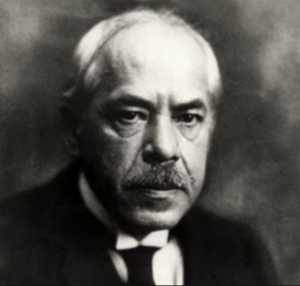 Concerning the history of Neurology in Romania, the most prominent scientific figure of the past has been for certain Prof. Gheorghe Marinescu. Educated in Paris, student of Charcot and colleague of Pierre Marie, Joseph Babinski and Fulgence Raymond, he was the artisan of neurological sciences in Romania. Prof. Marinescu also remained in the history of Medicine for at least two things: his monography, published in 1909 ”La cellule nerveuse”, and for the first scientific films, registered in Bucharest between 1898-1901. Other important works are related to the identification of senile placques in the brain (together with Paul Blocq), the description of a rare genetic disease (Marinescu-Sjögren syndrome), and the description of the ”succulent hand” in syringomielia. He was the chair of the Neurology Clinic at Colentina Hospital for 41 years and he founded the Romanian School of Neurology and also the Romanian Society of Neurology.
Concerning the history of Neurology in Romania, the most prominent scientific figure of the past has been for certain Prof. Gheorghe Marinescu. Educated in Paris, student of Charcot and colleague of Pierre Marie, Joseph Babinski and Fulgence Raymond, he was the artisan of neurological sciences in Romania. Prof. Marinescu also remained in the history of Medicine for at least two things: his monography, published in 1909 ”La cellule nerveuse”, and for the first scientific films, registered in Bucharest between 1898-1901. Other important works are related to the identification of senile placques in the brain (together with Paul Blocq), the description of a rare genetic disease (Marinescu-Sjögren syndrome), and the description of the ”succulent hand” in syringomielia. He was the chair of the Neurology Clinic at Colentina Hospital for 41 years and he founded the Romanian School of Neurology and also the Romanian Society of Neurology.
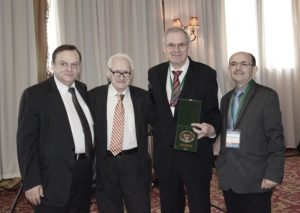
Prof. Ovidiu Alexandru Bajenaru, Honorary President ad vitam of the Romanian Society of Neurology, Prof. Alexandru Serbanescu, Prof. Günther Deuschl receiving the ”Gh Marinescu” medal and Prof. Dafin Muresanu, current president of the Romanian Society of Neurology
The Society was abusively dissoluted in 1948 by the former communist regime, and was reinstated in 2001 as the legal continuator of the first Romanian Society of Neurology by Prof. Ovidiu Bajenaru, who is presently, without doubt, the most prominent scientific figure. Every step in our development as clinicians, researchers or teachers has been enthusiasthically supported by him, having in mind one single goal: to raise Romanian Neurology to European standards.
The Annual Congress of our Society is usually held in the month of May, gathering the majority of the 1,250 Romanian neurologists. To honor the achievements and the memory of Gheorghe Marinescu, the Romanian Society of Neurology has created a medal with his effigy and begins its annual national conference with the Honorary Conference ”Gheorghe Marinescu”, held by renown contemporary personalities from all over the world.
The Romanian Journal of Neurology has been published constantly since 2001, thank to the constant work of Prof. Bogdan Popescu, with the support of the neurological academic community. It is indexed in several databases, and is very close to be listed on Pubmed. Romanian neurologists are actively participating to international conferences, presenting their research or being involved as lecturers. Young neurologists are encouraged to present their work, and starting with 2017 there will be a special section in the national conference, dedicated to the residents.
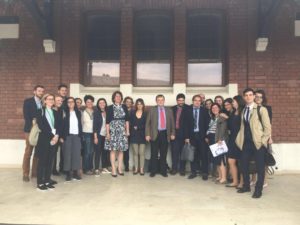
Prof. Ovidiu Alexandru Bajenaru and Assoc. Prof Cristina Tiu surrounded by the residents and young specialists at the National Conference of the Romanian Society of Neurology, 2016
Within the 17 years since it was reorganized, the Romanian Society of Neurology (www.neurology.ro) has been the promoter of education and research, gathering the best neurologists in the country in a constant effort to organize numberless workshops, conferences and symposia. Prof. Rodica Balasa, Prof. Bogdan Popescu, Prof. Mihaela Simu, Assoc. Prof Cristina Tiu, Assoc. Prof Sorin Tuta, and the regretted Prof. Cristian Dinu Popescu, who prematurely left us this year, brought their contribution to the educational process of entire generations of young neurologists.
Progresses have been achieved in the field of stroke, epilepsy and movement disorders. A national programme for thrombolysis and interventional treatment in stroke (including endovascular thrombectomy and coiling of ruptured aneurysms) initiated by the Romanian Society of Neurology and sustained by the Ministry of Health since 2014 allowed the opening of ten stroke units and an important increase in the number of iv thrombolysis (over 1000 patients in 2 years). Patients with Parkinson’s Disease have access to Deep Brain Stimulation or pumps, patients with dystonias to botulinum toxin, patients with epilepsy to surgery, and study of sleep disorders. We are partners in many research projects, we are constantly growing, and our voice is more and more heard in the international neurological community.
Please read articles by Romanian co- authors published in the European Journal of Neurology here.
We welcome everybody who wants to know us better !
Prof. Cristina Tiu, University of Medicine and Pharmacy ”Carol Davila” Bucharest, Dept. of Clinical Neuroscienses, University Hospital Bucharest, Head of Neurology II Dept.





